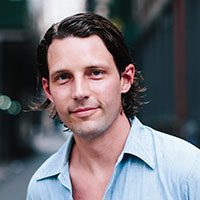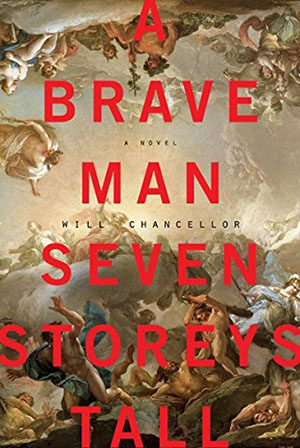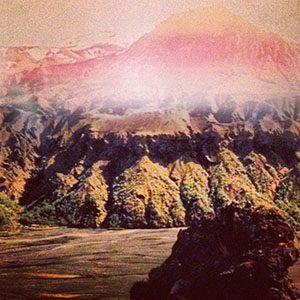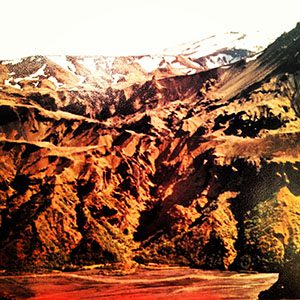
Will Chancellor’s debut novel, A Brave Man Seven Storeys Tall, is an epic bildungsroman about an athlete-turned-artist, Owen Burr, who, in the opening pages of the book, suffers a gruesome, career-ending injury during a college water polo match. That loss ends his bid to compete in the Olympics, but it doesn’t lessen his ambition. As he convalesces with his father, Joseph—an intelligent but underappreciated Classics professor—Owen decides to sneak off to find his way as a contemporary artist in Berlin. Before he disappears, though, he steals one of his father’s heavy tomes, a book Chancellor says has cast a shadow on every father and son story written in the nearly 3,000 since its telling: Homer’s The Odyssey.
Chancellor spent eleven years writing A Brave Man Seven Storeys Tall, and in the process of researching it he played water polo, wore an eyepatch for extended periods of time, traveled alone across Iceland for eight weeks, and collaborated on an interactive sculpture installation for the New Museum’s Festival of Ideas for a New City. The novel’s language is lyrical, but concise. A passage toward the end of the book about the melting ice sheets off Greenland’s coast is a good example: “By December an elastic skin of ice reached out hundreds of miles into the sea, rolling with every wave.” The novel is organic, but highly structured, a journey mapped onto other texts, books you don’t have to read to enjoy Chancellor’s wild, mythic tour de force.
***
The Rumpus: Let’s start at the very beginning. This is a complex novel—a lot of philosophy, a lot of references, and a strong plot. Where did the idea for this book come from?
Will Chancellor: There’s a section halfway into Chapter Three where Owen is sitting with Stevie at a café in Berlin. It’s the first time he’s hanging out with her; he’s on mushrooms, tripping his face off. She holds up this salt canister with a cartoon of Poseidon on the label and says, “Isn’t this drawing great?” He says, “I don’t think it’s that accurate.” She says, “It’s a cartoon of a god—what do you mean it’s not accurate? That’s a weird choice of words.” He says, “Well. I’ve always thought Poseidon would look like me.”
 That conversation more or less actually happened. This was 1996, during my freshman year at Stanford. It’s the first day of class, and I’m in a seminar with ten people. The professor put up a projection of a statue of Poseidon and asked what we thought. We were all nervous, looking at our laps. Then this guy raised his hand and that’s what came out: “I always thought Poseidon would look like me.” I thought, “Who the hell says something like that?”
That conversation more or less actually happened. This was 1996, during my freshman year at Stanford. It’s the first day of class, and I’m in a seminar with ten people. The professor put up a projection of a statue of Poseidon and asked what we thought. We were all nervous, looking at our laps. Then this guy raised his hand and that’s what came out: “I always thought Poseidon would look like me.” I thought, “Who the hell says something like that?”
The book came from that one quote. But it’s funny. My college class wasn’t huge, and I think I made a conscious effort to not get to know this particular guy because at some level I knew I’d be fictionalizing that moment.
But I see A Brave Man Seven Storeys Tall as really being the story of Owen’s father, Professor Burr, and not the story of Owen, because the father is trying to answer the same question I was trying to answer when I started the book: “What kind of a person says something like that?” To the father, it’s an acute problem, because this is his son—presumably, the flesh of my flesh and so on, but instead, here’s this blonde little hero that he can’t relate to at all.
Rumpus: Professor Burr, Owen’s father, is a sort of down-and-out academic who has written a useless book on ancient words. The kids in the university bookstore use unsold copies to build an igloo so they have a place to smoke pot in the storeroom. This is a darkly funny portrait of academia, but it’s not exactly cruel, either. It’s exaggerated, pointed, and funny without being over the top. Is it satire?
Chancellor: Burr has written literally the most useless book ever: A dictionary of words that cannot be defined with other words, Hapax Legomena.
Instead of satire, I prefer the word playful. I love Burr to death. He’s everything to me. I think any successful satire has that element of love to it—otherwise it’s just tiresome. The book is meant to be playful. But I should add that there’s nothing dismissive in the way I’m using that word. Playful doesn’t mean less rigorous. Writing is more like the serious, world-building play of children than the jetski Vegas play of adults. To me, the ludic spirit is what makes fiction work. And a lot of so-called serious literature, like Shakespeare, is seriously playful.
If we’re talking about the autobiographical aspects of this novel, especially those involving the art world, it’s me moving from hateful satire to play. I started writing this novel as a smear campaign against contemporary conceptual art. I thought Tracey Emin neons were just bad poetry, or Yves Klein conceptual sculptures were just cheap appropriation of theory. After I had written the first draft, I thought, “If I’m writing about this, I should actually do it.” I was fortunate enough to have a friend, Daniel Subkoff, who is a successful conceptual artist. I was talking to him about a concept in Brave Man, the primacy of the liminal, and he said, “What you’re talking about is really close to a central theme in my work.” He then asked me if I wanted to collaborate on a conceptual sculpture.
Daniel and I must have gone to a hundred galleries together in 2010. The way he interacted with installations taught me how to see contemporary art. For example, we rounded a corner at a downtown gallery and saw thousands of brass chains hanging from the ceiling. Without a moment’s pause, he began blowing on the chains until the entire piece was oscillating in a harmonic wave. It was beautiful. He added time and motion, intuitively, to something static.
We talked materials, discussed Fluxus artists every day over text and in person, and in the end applied for the New Museum’s Festival of Ideas for a New City. After nearly a year and a half of deciding how to translate Liminality into a collaborative effort, we began constructing a 14-foot clay sculpture.
People came into the gallery, took handfuls of the clay from the central 14-foot sculpture, and pressed it into these small molds we had cast of a liberated god—long story. We chose a specific type of clay that would support the growth of wildflower seeds that were scattered throughout the piece. Gradually, over the course of three or four days, people hollowed out the central sculpture. Viewers left the gallery with a small statue and a choice: if they chose to hold on to the statue and put it on a shelf, it would crumble; alternatively, if they chose to put the sculpture in an abandoned lot or in a park, wildflowers would crack through the statue and bloom.
The important part for the book was this: During the year and a half I was working with Daniel and seeing how he viewed art, I completely changed my opinion of these artists and, more generally, contemporary art. Suddenly, things I formerly didn’t know how to see became clear. The book is much richer because of that experience making large-scale conceptual art—selecting materials and forms; thinking about what’s not included instead of what is included; trying to visually depict an abstract idea. I went from attacking a genre of art to admiring it. The book is meant to be somewhere in between those two poles of hate and admiration. It’s meant to be both critical and praising—not simply satire, certainly not serious. I hope it’s that in-between space that the reader is left in.
Rumpus: You mentioned the “autobiographical aspects” of the novel, but this isn’t an autobiographical novel, is it?
 Chancellor: There’s almost zero autobiography in this book. Some of it ended up being retroactive autobiography—meaning I re-enacted my story. Mid-third draft, I traversed Iceland because I had written about it years prior. I did almost all this stuff long after writing about it. When I started, I was really just digging around to solve that psychological riddle. Someone saying that a statue of Poseidon wasn’t accurate—it was so far from anything I had encountered. I turned to ancient myths. One thing that clicked for me as I was exploring was “The Sagas of Icelanders,” specifically the warrior-poet sagas.
Chancellor: There’s almost zero autobiography in this book. Some of it ended up being retroactive autobiography—meaning I re-enacted my story. Mid-third draft, I traversed Iceland because I had written about it years prior. I did almost all this stuff long after writing about it. When I started, I was really just digging around to solve that psychological riddle. Someone saying that a statue of Poseidon wasn’t accurate—it was so far from anything I had encountered. I turned to ancient myths. One thing that clicked for me as I was exploring was “The Sagas of Icelanders,” specifically the warrior-poet sagas.
Rumpus: Tell me about the 11 years you spent writing. Were you drafting throughout those years? Did you have a sense of the novel’s shape as you went?
Chancellor: In 2004, I moved to New York with a 1,200-page draft of this book and tinkered around for three years. Then I hit CONTROL-A, DELETE, and started over on page one. I wrote a second draft, told from the first-person, which was like The Talented Mr. Ripley. I liked that draft. I thought it was engaging. It was a fun draft, but it ended up being just the shadow of the story I wanted to tell. So I deleted it and started over.
Rumpus: You must know working like that is a long literary tradition—I mean, destroying drafts. Fyodor Dostoevsky burned Crime and Punishment. I looked it up just now. He wrote to a friend in 1866: “At the end of November much had been written and was ready; I burned it all; I can confess that now. I didn’t like it myself. A new form, a new plan excited me, and I started all over again.”
Chancellor: I definitely knew the image of throwing a manuscript in a fire. For me, that time spent on early drafts was the time it takes to learn how to write; I just learned through this story of Stevie and the Burrs. I didn’t know that most people rewrote their books. I thought they wrote a draft, put it in a drawer if it didn’t work, and started another project. The band Orange Juice has a song called “Rip It Up and Start Again.” I wish I’d found this method sooner. I spent four years trying to make something unwieldy, something that was simply a bad story, into something readable. Now I try to do very little tinkering. I write it straight out.
Rumpus: Thinking that good parts will surface naturally and bad parts will fall away?
Chancellor: Yeah. I want a lot of things in my fiction to function like images in a Memory Palace. I want images to stick. My first rule, I guess, is for people to read and finish the book. After that, I want people to have imagery that they can conjure easily. That’s the core. I rarely edit out images. The rendering of an image, the seeing, is what changes draft by draft. I wish someone had told me, “Don’t tinker. Read it, absorb it, delete it, and start again.” That would have saved me a ton of time. When I started on the second draft of this novel, everything that was good stayed. The trash was gone. I think I’m always going to write like that now.
Rumpus: There’s a reference to that in the book—Stevie is a genius and memorizes books, and they talk about Memory Palaces. That’s the way people memorized the Odyssey and the Iliad. They’d focus on the images, not the story.
Chancellor: Exactly. For me, everything in my life has been filtered through this book. Every input in my waking life, I think, “How does that interact with the novel?” And, now that I’ve more or less moved on, it’s like that for the second book, too. I process experience through my books—so far at least. Sometimes images pop up, other times they don’t. I liken the images in a text to the handholds in rock climbing. I start with one image that grounds me in the story. I trust that one hold and then stretch to the next image. For instance, I’m reading Underworld right now. You begin with the baseball game. The first close image, at least that I remember now, is the boy vaulting over the turnstile. I get closer and closer to that image. I see the scrapes on the metal, feel the texture, see the guards’ wool uniforms and billy clubs and cuffs and then on to the next image: a blanket hanging in a radio booth…
Rumpus: I’m not Luddite, but a Memory Palace might be the kind of thing we’re losing in this Age of Instant Recall—every piece of information that’s ever existed, you can search it on the Internet, like I did with the Dostoevsky quote a minute ago.
Chancellor: In 2006, I tried to found an Internet startup to teach people to memorize vast chunks of Wikipedia. My goal was to map curated entries of Wikipedia onto buildings in cities. You’d geolocate the page about the Russian Revolution onto the Chrysler Building or the Franco-Prussian War onto the Flatiron. Every city had a different field of knowledge (New York was World History because dates worked well with a grid system). I had this idea because I found I was taking in more information than ever, but losing it all. It’s always hard to extrapolate from your personal experience to talk about something much larger, like we’re doing now. There was a point four or five years ago when I was so bombarded by information I couldn’t remember anything. But I think I’ve gotten better at processing information since then. Was it developmental? Do the people in your neighborhood feel this way? Who knows?
Rumpus: There are a lot of references in this book to other works and to classical Greek myths. How do you bring in these other works while keeping the plot in A Brave Man moving forward? You don’t feel the weight of the myth, but you can tell some thought went into it, even if it doesn’t slow the narrative down.

Chancellor: The book that made me seriously consider becoming a writer was Michael Cunningham’s The Hours. It’s hard to explain, but the way he used the scaffolding in that book made intuitive sense to me. I’d found the text I wanted to work with for my novel, The Sagas of Icelanders, and I did a kind of one-to-one mapping with that. I also wanted it to be the story of the growth of an artist, a bildungsroman—that was another layer. I’d read about the six stages of artistic growth in Harold Bloom’s The Anxiety of Influence. So I had those two mapping systems. It was always “seven storeys tall,” and it was always going to be seven chapters mapped to Icelandic sagas. Plus, Owen’s artistic growth followed six clear and different stages. The biggest English-language novel to me is Ulysses. So I added this third layer of mapping. That’s why my first draft was so unwieldy. As I became a better writer, I removed all of those explicit reference points. I freed myself up to just write and tell the story. By the third draft, the scaffolding was gone, but the references remained as vestiges.
You can’t really get away from it. The image that’s really tough to get beyond, when you’re putting a book into the world, is going to the ocean with an eyedropper. “OK. Here’s my contribution to world literature!” It’s impossible to think about any work without the context of what goes in to making us readers. It’s important to me that there’s that undercurrent in my writing. It’s also important not to mistake an undercurrent for a story. The first draft of Brave Man was insufferable: reference, reference, reference. Now, it’s all there, but only if you want to dig for it.
For example, in both the Odyssey and Ulysses, you start with the story of the son—Telemachus, a boy in search of his father. When you get past the Telemachiad and into Book V, you find out that the story isn’t about really about the son. Maybe even more so in Joyce than in Homer. The concern we had as readers at the outset was minor. There’s always some element of the Odyssey in a Father-Son Story. So if you know the Odyssey well, it helps make sense of the two threads in Brave Man. It doesn’t help for readability, though. Allusions sap readability. The most important thing to me is, “Do readers want to turn the page?” I never want to alienate anyone. Reference is kind of like writing a sex scene in that way: what’s perfectly normal to you may strike a reader as fetishism.
The reality is if you lose someone, it’s your fault. There’s so much good media out there. Why not watch The Wire or Breaking Bad instead of read a novel? They’re great. They do a very good job of telling a longform story. I try to be mindful that novels are now competing with different media. But fiction still has advantages. Readers complete a novel. I want my book to feel like a dream while you’re still inside the dream. There’s no question about the logic of how things are related when you’re inside a dream. But then when you look back on it, it might seem unbelievable. While you’re in it, the logic is incredibly tight.
Rumpus: You say writers have to be readers first. What books and authors do you love?
Chancellor: I wasn’t much of a reader until 16 or 17. The greater part of my high school education was policy debate. Every Thursday I’d leave school and argue language, philosophy, and nuclear war for 40 hours over the weekend. I read all sorts of nonfiction, from theory to Black’s Law Dictionary, but not much fiction.
Tom McCarthy is one of my favorite living novelists. Remainder was in my pitch to HarperCollins—along with Helen Dewitt’s The Last Samurai. I read like a madman after college, first going one-by-one through Anthony Burgess’s 99 best English novels since 1939. I’m most at home in continental European literature. I misread a lot of poetry. For the past few years I’ve been focusing on what I see as a genealogy of Yeats, Eliot, Stevens, Frost, Lowell, Brodsky, Heaney, and Walcott. Maybe add Alice Oswald to that family tree. Memorial is outstanding.
There’s this idea in my head that summer debuts are like a freshman class. So far this summer, I’ve read and loved Kate Zambreno’s Green Girl, Smith Henderson’s Fourth of July Creek, Scott Cheshire’s High as the Horses’ Bridles, Edan Lepucki’s California, and Lacy Johnson’s The Other Side. Also Catherine Lacey’s Nobody is Ever Missing and David Burr Gerrard’s Short Century. The coolest part about publishing is being able to read contemporary fiction without howling jealousy. There’s some amazing new writing out there that I used to be too self-conscious to enjoy. Now I can read with the childish playfulness I used to reserve for the canon. There are always interesting and insightful new books being written: It’s an amazing time to be a reader.
***
Featured image by Atisha Paulson.
Photographs of Iceland courtesy of Will Chancellor.




